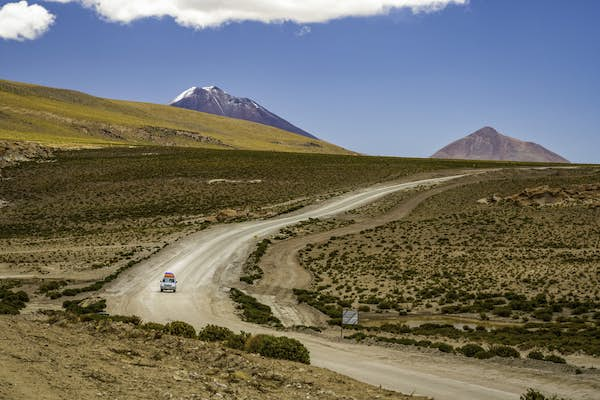7 best road trips in Bolivia
6 min read
Though the highways are mostly well-maintained, driving in Bolivia can be stressful due to unpredictable drivers, landslides depending on the season and last-minute roadblocks that derail your schedule. But the stunning landscapes – including Lake Titicaca, the world-famous Uyuni Salt Flats and Tarija wine country – make any road trip worth it.
These eight itineraries range from the most famous attractions in Bolivia to emerging traveler destinations, from the soaring Andes to the relaxed vibes of eastern villages.
1. The road to Sorata
Best road trip for stunning scenery
La Paz–Sorata; 142km (88 miles); allow two days
Driving in La Paz can be stressful due to its ups and downs and messy traffic disruptions, but it’s worth it for everything you’ll see later.
Along the road to Sorata, through National Route 2 and Road 16, there are impressive views of the Cordillera Real mountains and Lake Titicaca, one of the top destinations in Bolivia. Plus, whenever it’s clear you’ll see the towering, snowcapped peaks of Ancohuma and Illampu.
Sorata is a town with a laid-back atmosphere that lies in a valley beneath majestic mountains and canyons – a great spot for hikers.
Detour: Thirty minutes away from Sorata on a dusty road, there’s a navigable lagoon inside a cave, which is the town’s main attraction. You can see it walking on a three-hour easy hike.
2. The Andes to the Amazon rainforest
Best road trip for nature lovers
La Paz–Coroico; 108km (67 miles); allow two days
This route has an outstanding diversity of landscapes, departing from the bustling city of La Paz and finishing up in the warm and friendly village of Coroico through Road 3. In two hours, you’ll descend from the summit and snowy peaks of the Andes into the Amazon rainforest – a drop in altitude of 3,600m (11,482ft) with many scenic spots to take photos along the way.
The most famous way to get to Coroico is by bicycle on what’s known as “Death Road,” though that can be challenging for some people. Road-tripping on a different route offers a less risky alternative – and equally wonderful views.
Planning tip: You may experience fog and rain in the descent, so it’s better not to travel to Coroico at night.
3. La Chiquitania
Best road trip for architectural heritage
Santa Cruz–Santa Cruz; 934km (580 miles); allow five to six days
Discover several centuries-old Jesuit Mission towns among epic landscapes and natural attractions in eastern Bolivia’s La Chiquitania. In this multi-day itinerary, you’ll get the chance to visit at least four small towns and explore their ancient baroque architecture.
Between Santa Cruz and San Jose, you should make three must-see stops in San Javier, Concepción and San Ignacio. Visit the churches and museums for a complete experience.
Detour: If you’re not in a rush to get back to Santa Cruz, you can pivot 150km (93 miles) to the east and visit Aguas Calientes for a short break in relaxing thermal baths.

4. Ancient cities and historic attractions
Best road trip for historical immersion
Sucre–Potosí; 155km (96.3 miles); allow three days
Sucre is one of the best-preserved ancient cities in South America, where colonial and republican buildings emerge from the white-painted downtown. From there, hit Road 5 to Potosí to explore what once was the world’s biggest and most important city, thanks to silver production in colonial times. Both cities have several historical attractions that make them well worth a visit.
The road also has interesting spots. Just a few minutes after departing, you’ll find El Castillo de la Glorieta, an eclectic castle built during the late-19th century for Francisco and Clotilde Argandoña, who received an honorary title declaring them prince and princess, becoming the only royalty in Bolivia’s history.
You’ll also pass several small agricultural towns that may not be a great attraction for tourists, but do have wonderful artisan markets to visit.
Planning tip: Potosí is the highest city in the world, at an altitude of 4,067m (13,343ft). Drink coca tea and plenty of water during the trip to avoid sickness.

5. Uyuni Salt Flats
Best road trip for a once-in-a-lifetime experience
Potosí–Uyuni; 205km (127 miles); allow five days
There are many ways to reach Bolivia’s most famous attraction: the otherworldly Uyuni Salt Flats. The easiest is a three-hour drive on Road 5 from Potosí to Uyuni, a well-maintained route with impressive views of the Andean wildlife and scenery.
Although Uyuni is an underfunded town with few amenities, it’s the main entrance to the salt flats and its surroundings. Reserve at least four days for a complete tour that includes the volcanos, geysers and bizarre colorful lagoons inside Eduardo Avaroa Andean Fauna National Reserve.
Planning tip: This is a harsh environment for vehicles, and breakdowns may happen. You might want to hire a local guide and car to get into the flats. There are several tour operators in Uyuni, but it’s better to book in advance.

6. Tarija wine country
Great road trip for getting off the beaten path
Potosí–Tarija; 348km (216 miles); allow three days
It’s not a secret anymore that Bolivia produces good quality wines. On this route, which winds from Potosí to Tarija through Road 1, you’ll pass through Camargo and Villa Abecia, two small towns dedicated to the artisanal production of wine and singani, a beverage distilled from white grapes that’s only made in these valleys.
If you go in summer, it’s a perfect time to enjoy the area’s natural attractions, including river bathing and easy hiking trails.
The trip ends in the charming city of Tarija, where the wine industry is one of the main economic activities. There you’ll find plenty of wineries in epic scenery, surrounded by hills and vineyards reminiscent of Tuscany.
Local tip: The best time to visit these valleys is by mid-March, when the Grape Harvest Festival takes place.

7. Samaipata and the valleys of Santa Cruz
Best road trip for camping and waterfalls
Santa Cruz–Samaipata; 121km (75 miles); allow two days
Samaipata and the route to the valleys of Santa Cruz have plenty of natural attractions all the way through Road 7. On an undulating road bordering rivers and climbing hills, you will pass by Las Cuevas, a perfect stop to camp safely and enjoy the waterfalls.
The small town of Samaipata is quiet and peaceful, but with a broad range of accommodations and food amenities, it’s becoming the region’s favorite tourist destination and one of the main entrances to Amboró National Park.
You can discover nearby attractions at your own pace, hiking into the famous fern forest or visiting the pre-Columbian archaeological ruins of El Fuerte, a huge, sculpted rock listed as a Unesco World Heritage site.
Planning tip: Weekends and holidays are particularly crowded and bustling in Samaipata. If you are looking for a quiet experience, choose to go on weekdays.
Tips for driving in Bolivia
Driving in Bolivia can become quite challenging, even for the most experienced drivers. Road conditions vary widely, but the main routes listed here are normally well-maintained.
However, roadblocks are not uncommon; ask locals for advice, and remember to check the Bolivian Roads Administration website for updates.
On the road, there are several checkpoints where you just pay the toll, but in some cases you’ll need to walk to a nearby police station to show your driver’s license.
In the cities, traffic can be heavy, drivers are often unpredictable and there’s a lack of proper traffic signals, which could cause more than a headache behind the wheel. Watch out for unexpected potholes and speed bumps that might not always be visible.





